Food Safety Management
VerifiedAdded on 2023/02/02
|11
|3018
|77
AI Summary
This document provides detailed information about food safety management, including methods of food preservation, temperature control system, safe storage of food, and more. It also discusses the importance of personal hygiene, cleaning and disinfection, pest control, and the need for hygienic design and construction of food premises. Additionally, it explains food hazard risk management, the food safety control system, and food safety guide for legislation compliance.
Contribute Materials
Your contribution can guide someone’s learning journey. Share your
documents today.
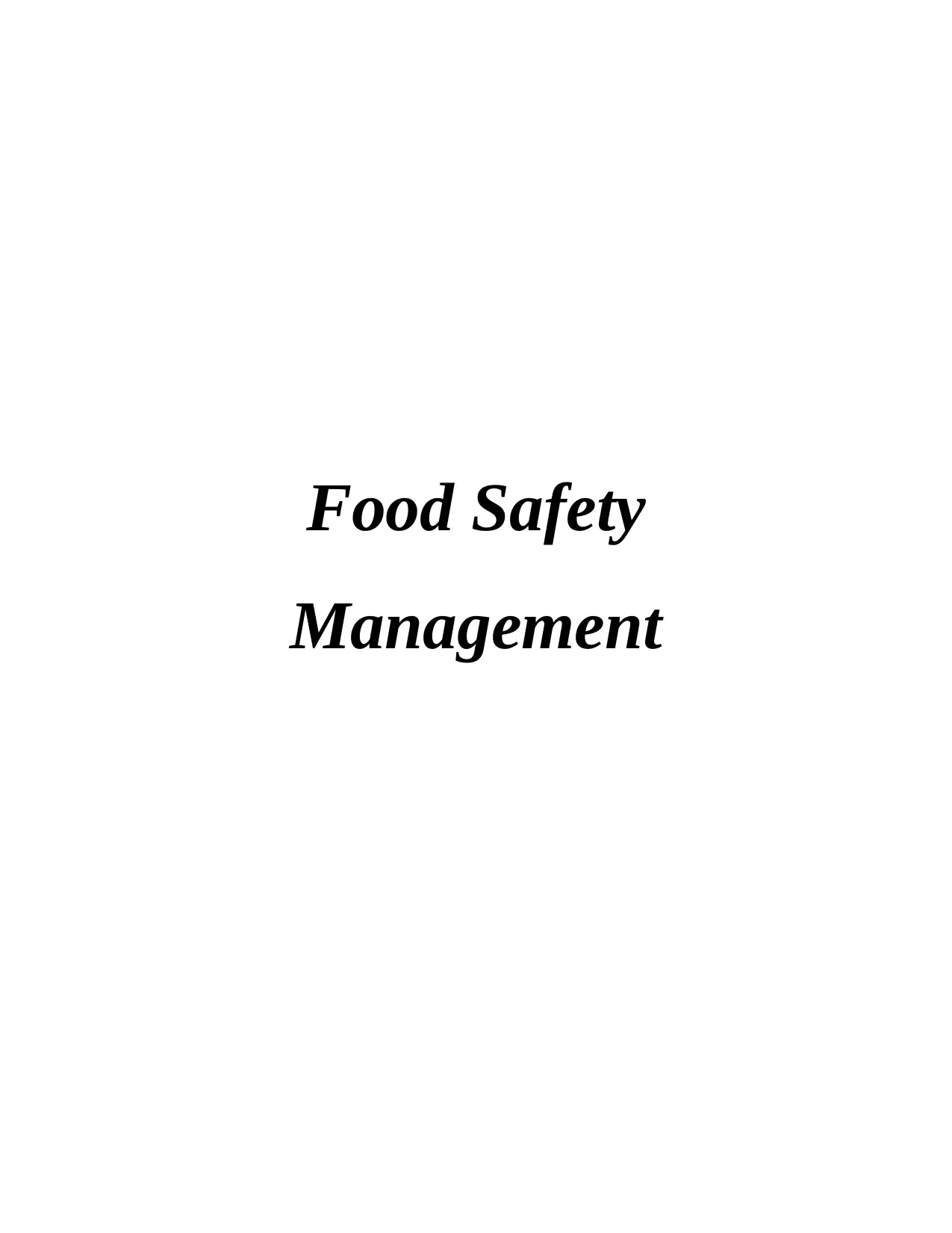
Food Safety
Management
Management
Secure Best Marks with AI Grader
Need help grading? Try our AI Grader for instant feedback on your assignments.
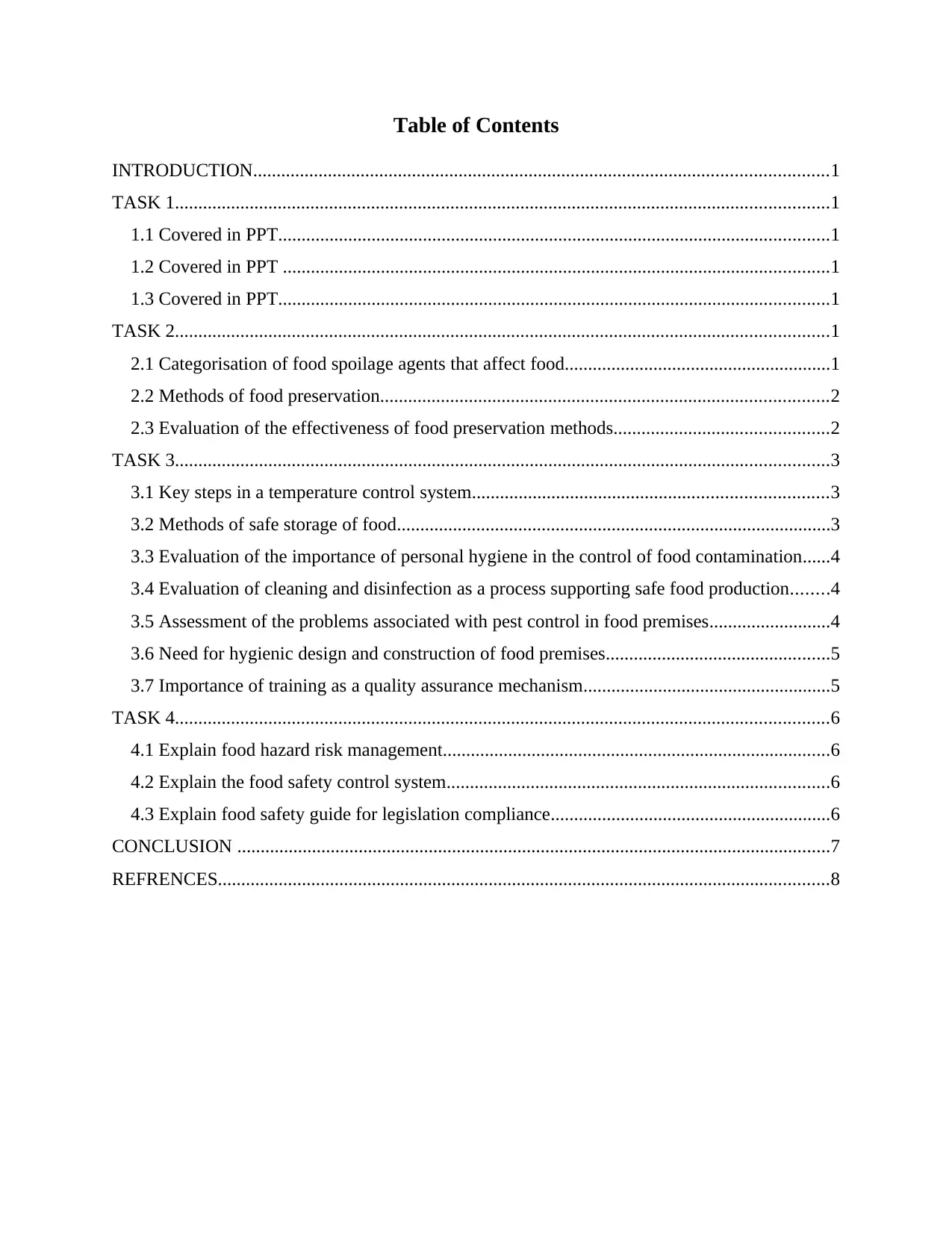
Table of Contents
INTRODUCTION...........................................................................................................................1
TASK 1............................................................................................................................................1
1.1 Covered in PPT......................................................................................................................1
1.2 Covered in PPT .....................................................................................................................1
1.3 Covered in PPT......................................................................................................................1
TASK 2............................................................................................................................................1
2.1 Categorisation of food spoilage agents that affect food.........................................................1
2.2 Methods of food preservation................................................................................................2
2.3 Evaluation of the effectiveness of food preservation methods..............................................2
TASK 3............................................................................................................................................3
3.1 Key steps in a temperature control system............................................................................3
3.2 Methods of safe storage of food.............................................................................................3
3.3 Evaluation of the importance of personal hygiene in the control of food contamination......4
3.4 Evaluation of cleaning and disinfection as a process supporting safe food production........4
3.5 Assessment of the problems associated with pest control in food premises..........................4
3.6 Need for hygienic design and construction of food premises................................................5
3.7 Importance of training as a quality assurance mechanism.....................................................5
TASK 4............................................................................................................................................6
4.1 Explain food hazard risk management...................................................................................6
4.2 Explain the food safety control system..................................................................................6
4.3 Explain food safety guide for legislation compliance............................................................6
CONCLUSION ...............................................................................................................................7
REFRENCES...................................................................................................................................8
INTRODUCTION...........................................................................................................................1
TASK 1............................................................................................................................................1
1.1 Covered in PPT......................................................................................................................1
1.2 Covered in PPT .....................................................................................................................1
1.3 Covered in PPT......................................................................................................................1
TASK 2............................................................................................................................................1
2.1 Categorisation of food spoilage agents that affect food.........................................................1
2.2 Methods of food preservation................................................................................................2
2.3 Evaluation of the effectiveness of food preservation methods..............................................2
TASK 3............................................................................................................................................3
3.1 Key steps in a temperature control system............................................................................3
3.2 Methods of safe storage of food.............................................................................................3
3.3 Evaluation of the importance of personal hygiene in the control of food contamination......4
3.4 Evaluation of cleaning and disinfection as a process supporting safe food production........4
3.5 Assessment of the problems associated with pest control in food premises..........................4
3.6 Need for hygienic design and construction of food premises................................................5
3.7 Importance of training as a quality assurance mechanism.....................................................5
TASK 4............................................................................................................................................6
4.1 Explain food hazard risk management...................................................................................6
4.2 Explain the food safety control system..................................................................................6
4.3 Explain food safety guide for legislation compliance............................................................6
CONCLUSION ...............................................................................................................................7
REFRENCES...................................................................................................................................8


INTRODUCTION
Handling, preparation and storage of food in a scientific manner that prevents edibles
from food-borne diseases. Organisations that are involved in hospitality industry are expected to
provide safe and wholesome food to large group of consumers. Large organisations working in
food industry needs to provided food which is safe for consumption and take all necessary
measures to prevent poisoning of food products. Unsafe food is linked to the deaths of millions
of people annually that includes many children. Food safety is getting more and more concern
globally and World Health Organisation is the highest authority for food safety concern at
international level. Organisation is continuously promoting its efforts for providing safe food
from farm to plates (Sawe, Onyango, and Njage, 2014).
In this project detailed information regarding agents that leads to food borne illness and
contamination of food. Effective process that helps in prevention of food from spoilage and
preserve food quality. Together with this report on food safety management and food hazard risk
management assessment is also mentioned in this report.
TASK 1
1.1 Covered in PPT
1.2 Covered in PPT
1.3 Covered in PPT
TASK 2
2.1 Categorisation of food spoilage agents that affect food
Food spoilage is the process in which food deteriorates to that extent in which it becomes
unsuitable for human consumption by reduced quality (Nychas, Panagou and Mohareb, 2016). It
is a disagreeable change in a foods normal state that can be deducted by smell, taste, touch and
by sight.
Foods and their spoilage agents are as-
Bacteria's: Milk products, Edibles like fruits an vegetables.
Fungi: Curd and processed foods.
Temperature and weather: Bakery items, meat, fried food etc.
Protease: Eggs, various flours and products containing crabs.
1
Handling, preparation and storage of food in a scientific manner that prevents edibles
from food-borne diseases. Organisations that are involved in hospitality industry are expected to
provide safe and wholesome food to large group of consumers. Large organisations working in
food industry needs to provided food which is safe for consumption and take all necessary
measures to prevent poisoning of food products. Unsafe food is linked to the deaths of millions
of people annually that includes many children. Food safety is getting more and more concern
globally and World Health Organisation is the highest authority for food safety concern at
international level. Organisation is continuously promoting its efforts for providing safe food
from farm to plates (Sawe, Onyango, and Njage, 2014).
In this project detailed information regarding agents that leads to food borne illness and
contamination of food. Effective process that helps in prevention of food from spoilage and
preserve food quality. Together with this report on food safety management and food hazard risk
management assessment is also mentioned in this report.
TASK 1
1.1 Covered in PPT
1.2 Covered in PPT
1.3 Covered in PPT
TASK 2
2.1 Categorisation of food spoilage agents that affect food
Food spoilage is the process in which food deteriorates to that extent in which it becomes
unsuitable for human consumption by reduced quality (Nychas, Panagou and Mohareb, 2016). It
is a disagreeable change in a foods normal state that can be deducted by smell, taste, touch and
by sight.
Foods and their spoilage agents are as-
Bacteria's: Milk products, Edibles like fruits an vegetables.
Fungi: Curd and processed foods.
Temperature and weather: Bakery items, meat, fried food etc.
Protease: Eggs, various flours and products containing crabs.
1
Secure Best Marks with AI Grader
Need help grading? Try our AI Grader for instant feedback on your assignments.

Thiaminase: Meat products and fishes.
2.2 Methods of food preservation
Preservation of food is required to manage freshness of the products and to use it for
longer duration of time. For this various methods are used which are as follows:
Canning: It is the process of applying heat to food products that's sealed in a jar in order
to destroy any microorganisms that can cause food spoilage, Example- dry fruits.
Freezing: It is an art of preparing, packaging and freezing foods at their peak of
freshness. Food products are freeze to maintain freshness of the products. Example- fruits and
vegetables (Pitt, Taniwaki and Cole, 2013).
Drying: It is an oldest method known for preservation of food products. In this method
food is exposed to a temperature that is high enough to remove the moisture but low enough that
it doesn't cook.
Salting: This method is used to minimise level of temperature form some specific food
items such as meat products. This helps in enhancing life of the product for which it can be
consumed.
2.3 Evaluation of the effectiveness of food preservation methods
Canning: This method is quite effective to provided packed products as chances of
moisture effects will be minimised and product will be fresh for longer duration of time.
Freezing: Various medicines and vaccines that are consumed by humans needs to be
kept in very low temperature to cure some disease and this method become very essential in
current scenario.
Drying: All the moisture available in the product is reduced to the level at which chances
of bacterial infection to food product is minimised and life of product got enhanced.
Salting: This method is used to preserve some special vegetables that improves life span
of the product and reduces bacterial infection to the product (Xue and Zhang, 2013).
2
2.2 Methods of food preservation
Preservation of food is required to manage freshness of the products and to use it for
longer duration of time. For this various methods are used which are as follows:
Canning: It is the process of applying heat to food products that's sealed in a jar in order
to destroy any microorganisms that can cause food spoilage, Example- dry fruits.
Freezing: It is an art of preparing, packaging and freezing foods at their peak of
freshness. Food products are freeze to maintain freshness of the products. Example- fruits and
vegetables (Pitt, Taniwaki and Cole, 2013).
Drying: It is an oldest method known for preservation of food products. In this method
food is exposed to a temperature that is high enough to remove the moisture but low enough that
it doesn't cook.
Salting: This method is used to minimise level of temperature form some specific food
items such as meat products. This helps in enhancing life of the product for which it can be
consumed.
2.3 Evaluation of the effectiveness of food preservation methods
Canning: This method is quite effective to provided packed products as chances of
moisture effects will be minimised and product will be fresh for longer duration of time.
Freezing: Various medicines and vaccines that are consumed by humans needs to be
kept in very low temperature to cure some disease and this method become very essential in
current scenario.
Drying: All the moisture available in the product is reduced to the level at which chances
of bacterial infection to food product is minimised and life of product got enhanced.
Salting: This method is used to preserve some special vegetables that improves life span
of the product and reduces bacterial infection to the product (Xue and Zhang, 2013).
2
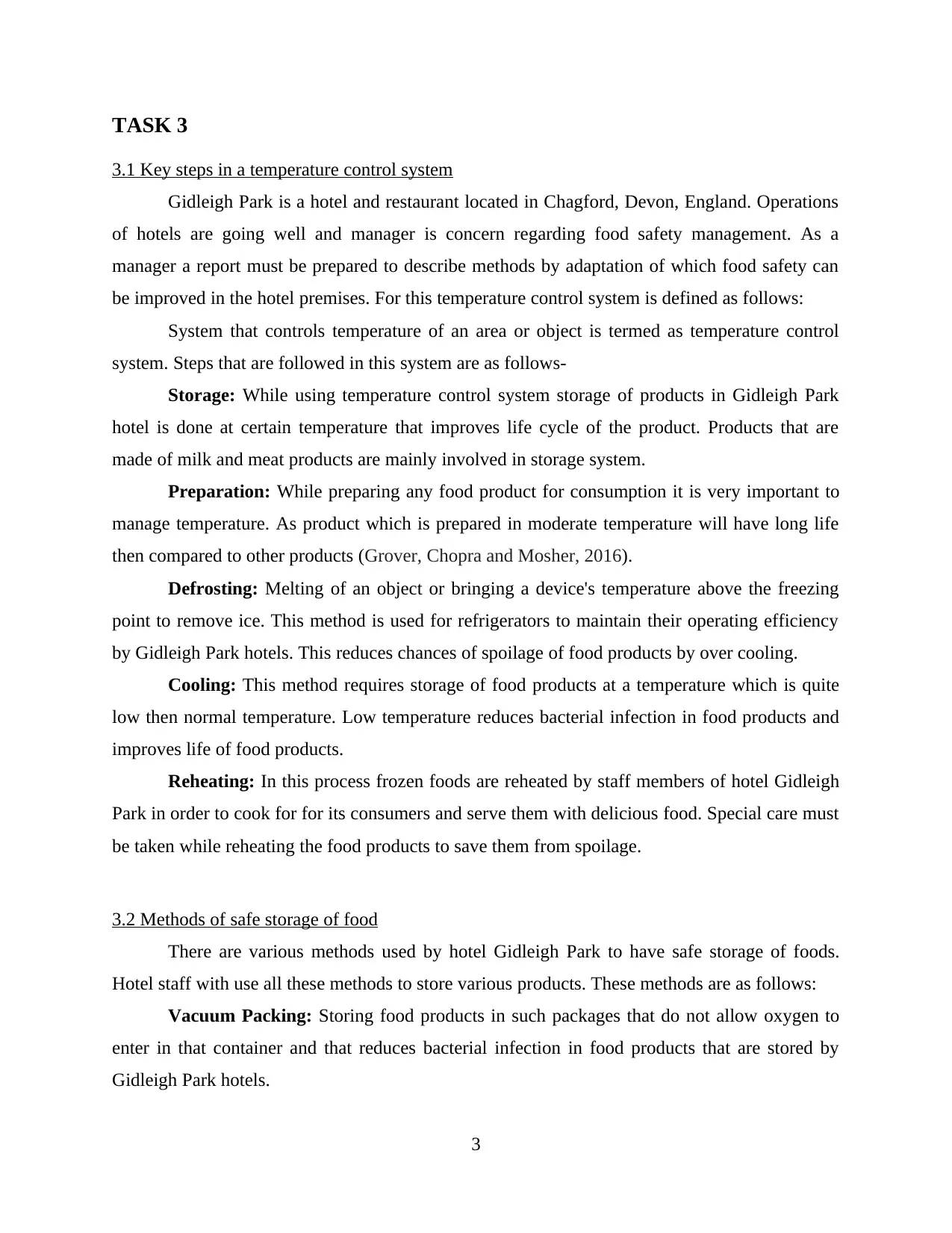
TASK 3
3.1 Key steps in a temperature control system
Gidleigh Park is a hotel and restaurant located in Chagford, Devon, England. Operations
of hotels are going well and manager is concern regarding food safety management. As a
manager a report must be prepared to describe methods by adaptation of which food safety can
be improved in the hotel premises. For this temperature control system is defined as follows:
System that controls temperature of an area or object is termed as temperature control
system. Steps that are followed in this system are as follows-
Storage: While using temperature control system storage of products in Gidleigh Park
hotel is done at certain temperature that improves life cycle of the product. Products that are
made of milk and meat products are mainly involved in storage system.
Preparation: While preparing any food product for consumption it is very important to
manage temperature. As product which is prepared in moderate temperature will have long life
then compared to other products (Grover, Chopra and Mosher, 2016).
Defrosting: Melting of an object or bringing a device's temperature above the freezing
point to remove ice. This method is used for refrigerators to maintain their operating efficiency
by Gidleigh Park hotels. This reduces chances of spoilage of food products by over cooling.
Cooling: This method requires storage of food products at a temperature which is quite
low then normal temperature. Low temperature reduces bacterial infection in food products and
improves life of food products.
Reheating: In this process frozen foods are reheated by staff members of hotel Gidleigh
Park in order to cook for for its consumers and serve them with delicious food. Special care must
be taken while reheating the food products to save them from spoilage.
3.2 Methods of safe storage of food
There are various methods used by hotel Gidleigh Park to have safe storage of foods.
Hotel staff with use all these methods to store various products. These methods are as follows:
Vacuum Packing: Storing food products in such packages that do not allow oxygen to
enter in that container and that reduces bacterial infection in food products that are stored by
Gidleigh Park hotels.
3
3.1 Key steps in a temperature control system
Gidleigh Park is a hotel and restaurant located in Chagford, Devon, England. Operations
of hotels are going well and manager is concern regarding food safety management. As a
manager a report must be prepared to describe methods by adaptation of which food safety can
be improved in the hotel premises. For this temperature control system is defined as follows:
System that controls temperature of an area or object is termed as temperature control
system. Steps that are followed in this system are as follows-
Storage: While using temperature control system storage of products in Gidleigh Park
hotel is done at certain temperature that improves life cycle of the product. Products that are
made of milk and meat products are mainly involved in storage system.
Preparation: While preparing any food product for consumption it is very important to
manage temperature. As product which is prepared in moderate temperature will have long life
then compared to other products (Grover, Chopra and Mosher, 2016).
Defrosting: Melting of an object or bringing a device's temperature above the freezing
point to remove ice. This method is used for refrigerators to maintain their operating efficiency
by Gidleigh Park hotels. This reduces chances of spoilage of food products by over cooling.
Cooling: This method requires storage of food products at a temperature which is quite
low then normal temperature. Low temperature reduces bacterial infection in food products and
improves life of food products.
Reheating: In this process frozen foods are reheated by staff members of hotel Gidleigh
Park in order to cook for for its consumers and serve them with delicious food. Special care must
be taken while reheating the food products to save them from spoilage.
3.2 Methods of safe storage of food
There are various methods used by hotel Gidleigh Park to have safe storage of foods.
Hotel staff with use all these methods to store various products. These methods are as follows:
Vacuum Packing: Storing food products in such packages that do not allow oxygen to
enter in that container and that reduces bacterial infection in food products that are stored by
Gidleigh Park hotels.
3
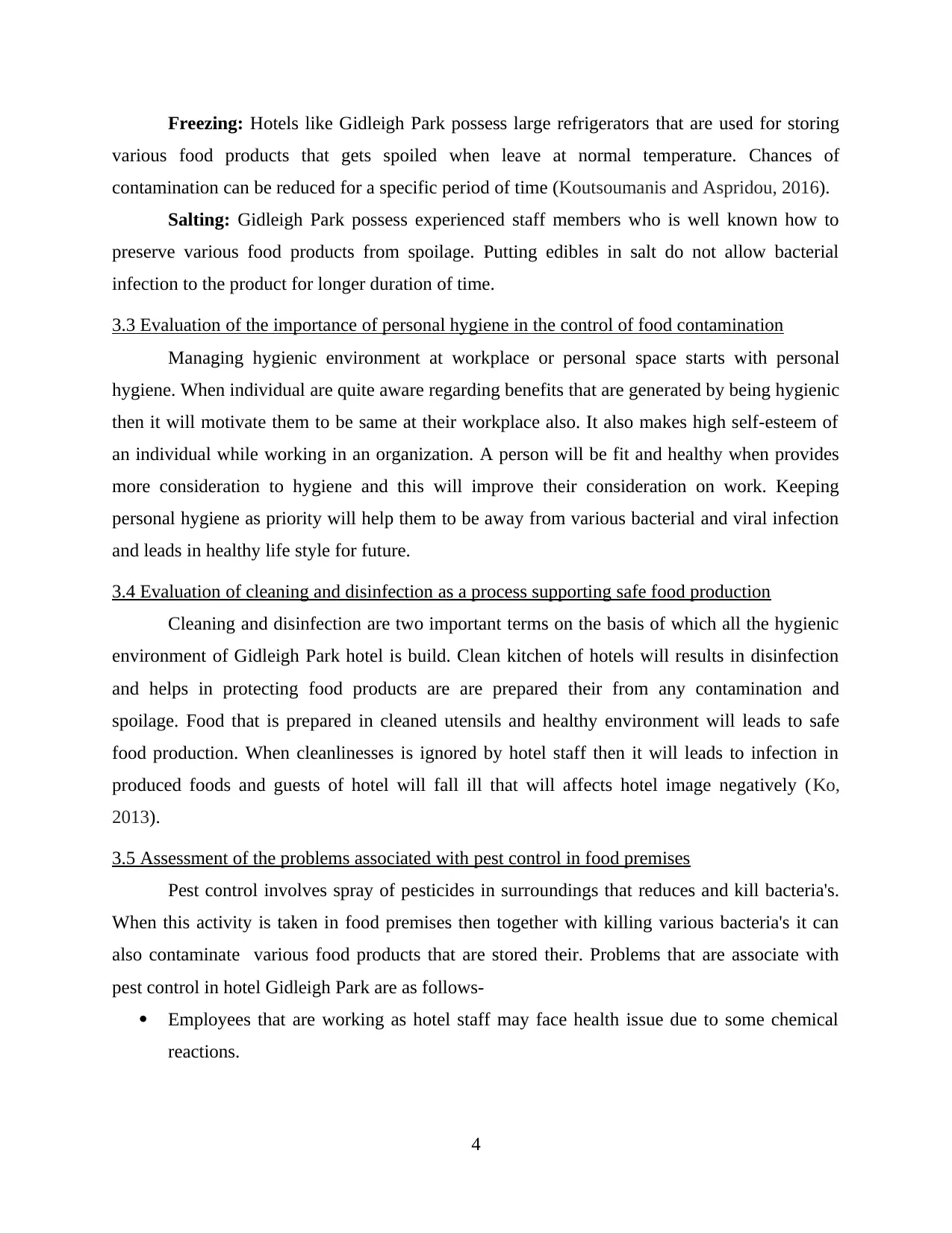
Freezing: Hotels like Gidleigh Park possess large refrigerators that are used for storing
various food products that gets spoiled when leave at normal temperature. Chances of
contamination can be reduced for a specific period of time (Koutsoumanis and Aspridou, 2016).
Salting: Gidleigh Park possess experienced staff members who is well known how to
preserve various food products from spoilage. Putting edibles in salt do not allow bacterial
infection to the product for longer duration of time.
3.3 Evaluation of the importance of personal hygiene in the control of food contamination
Managing hygienic environment at workplace or personal space starts with personal
hygiene. When individual are quite aware regarding benefits that are generated by being hygienic
then it will motivate them to be same at their workplace also. It also makes high self-esteem of
an individual while working in an organization. A person will be fit and healthy when provides
more consideration to hygiene and this will improve their consideration on work. Keeping
personal hygiene as priority will help them to be away from various bacterial and viral infection
and leads in healthy life style for future.
3.4 Evaluation of cleaning and disinfection as a process supporting safe food production
Cleaning and disinfection are two important terms on the basis of which all the hygienic
environment of Gidleigh Park hotel is build. Clean kitchen of hotels will results in disinfection
and helps in protecting food products are are prepared their from any contamination and
spoilage. Food that is prepared in cleaned utensils and healthy environment will leads to safe
food production. When cleanlinesses is ignored by hotel staff then it will leads to infection in
produced foods and guests of hotel will fall ill that will affects hotel image negatively (Ko,
2013).
3.5 Assessment of the problems associated with pest control in food premises
Pest control involves spray of pesticides in surroundings that reduces and kill bacteria's.
When this activity is taken in food premises then together with killing various bacteria's it can
also contaminate various food products that are stored their. Problems that are associate with
pest control in hotel Gidleigh Park are as follows-
Employees that are working as hotel staff may face health issue due to some chemical
reactions.
4
various food products that gets spoiled when leave at normal temperature. Chances of
contamination can be reduced for a specific period of time (Koutsoumanis and Aspridou, 2016).
Salting: Gidleigh Park possess experienced staff members who is well known how to
preserve various food products from spoilage. Putting edibles in salt do not allow bacterial
infection to the product for longer duration of time.
3.3 Evaluation of the importance of personal hygiene in the control of food contamination
Managing hygienic environment at workplace or personal space starts with personal
hygiene. When individual are quite aware regarding benefits that are generated by being hygienic
then it will motivate them to be same at their workplace also. It also makes high self-esteem of
an individual while working in an organization. A person will be fit and healthy when provides
more consideration to hygiene and this will improve their consideration on work. Keeping
personal hygiene as priority will help them to be away from various bacterial and viral infection
and leads in healthy life style for future.
3.4 Evaluation of cleaning and disinfection as a process supporting safe food production
Cleaning and disinfection are two important terms on the basis of which all the hygienic
environment of Gidleigh Park hotel is build. Clean kitchen of hotels will results in disinfection
and helps in protecting food products are are prepared their from any contamination and
spoilage. Food that is prepared in cleaned utensils and healthy environment will leads to safe
food production. When cleanlinesses is ignored by hotel staff then it will leads to infection in
produced foods and guests of hotel will fall ill that will affects hotel image negatively (Ko,
2013).
3.5 Assessment of the problems associated with pest control in food premises
Pest control involves spray of pesticides in surroundings that reduces and kill bacteria's.
When this activity is taken in food premises then together with killing various bacteria's it can
also contaminate various food products that are stored their. Problems that are associate with
pest control in hotel Gidleigh Park are as follows-
Employees that are working as hotel staff may face health issue due to some chemical
reactions.
4
Paraphrase This Document
Need a fresh take? Get an instant paraphrase of this document with our AI Paraphraser
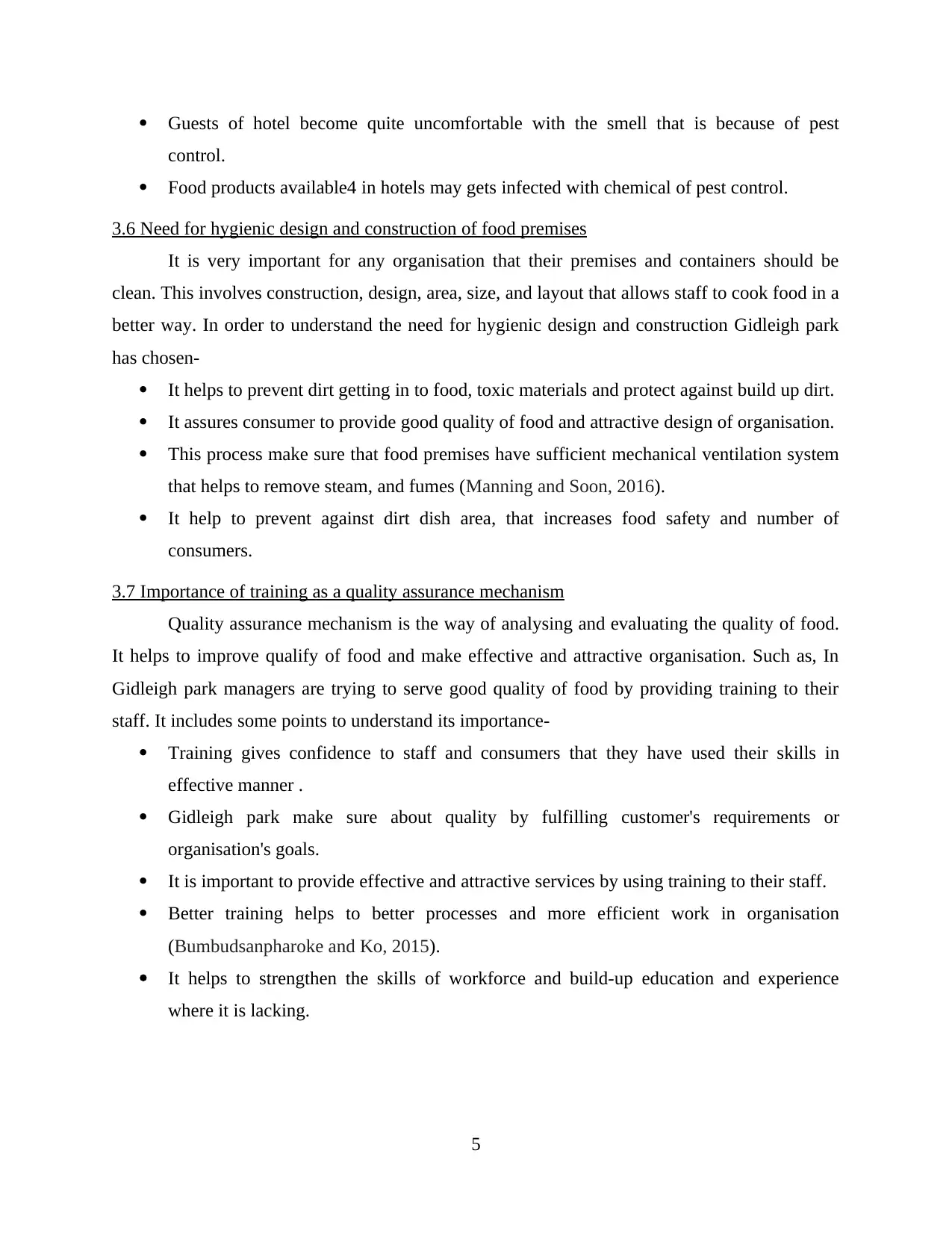
Guests of hotel become quite uncomfortable with the smell that is because of pest
control.
Food products available4 in hotels may gets infected with chemical of pest control.
3.6 Need for hygienic design and construction of food premises
It is very important for any organisation that their premises and containers should be
clean. This involves construction, design, area, size, and layout that allows staff to cook food in a
better way. In order to understand the need for hygienic design and construction Gidleigh park
has chosen-
It helps to prevent dirt getting in to food, toxic materials and protect against build up dirt.
It assures consumer to provide good quality of food and attractive design of organisation.
This process make sure that food premises have sufficient mechanical ventilation system
that helps to remove steam, and fumes (Manning and Soon, 2016).
It help to prevent against dirt dish area, that increases food safety and number of
consumers.
3.7 Importance of training as a quality assurance mechanism
Quality assurance mechanism is the way of analysing and evaluating the quality of food.
It helps to improve qualify of food and make effective and attractive organisation. Such as, In
Gidleigh park managers are trying to serve good quality of food by providing training to their
staff. It includes some points to understand its importance-
Training gives confidence to staff and consumers that they have used their skills in
effective manner .
Gidleigh park make sure about quality by fulfilling customer's requirements or
organisation's goals.
It is important to provide effective and attractive services by using training to their staff.
Better training helps to better processes and more efficient work in organisation
(Bumbudsanpharoke and Ko, 2015).
It helps to strengthen the skills of workforce and build-up education and experience
where it is lacking.
5
control.
Food products available4 in hotels may gets infected with chemical of pest control.
3.6 Need for hygienic design and construction of food premises
It is very important for any organisation that their premises and containers should be
clean. This involves construction, design, area, size, and layout that allows staff to cook food in a
better way. In order to understand the need for hygienic design and construction Gidleigh park
has chosen-
It helps to prevent dirt getting in to food, toxic materials and protect against build up dirt.
It assures consumer to provide good quality of food and attractive design of organisation.
This process make sure that food premises have sufficient mechanical ventilation system
that helps to remove steam, and fumes (Manning and Soon, 2016).
It help to prevent against dirt dish area, that increases food safety and number of
consumers.
3.7 Importance of training as a quality assurance mechanism
Quality assurance mechanism is the way of analysing and evaluating the quality of food.
It helps to improve qualify of food and make effective and attractive organisation. Such as, In
Gidleigh park managers are trying to serve good quality of food by providing training to their
staff. It includes some points to understand its importance-
Training gives confidence to staff and consumers that they have used their skills in
effective manner .
Gidleigh park make sure about quality by fulfilling customer's requirements or
organisation's goals.
It is important to provide effective and attractive services by using training to their staff.
Better training helps to better processes and more efficient work in organisation
(Bumbudsanpharoke and Ko, 2015).
It helps to strengthen the skills of workforce and build-up education and experience
where it is lacking.
5
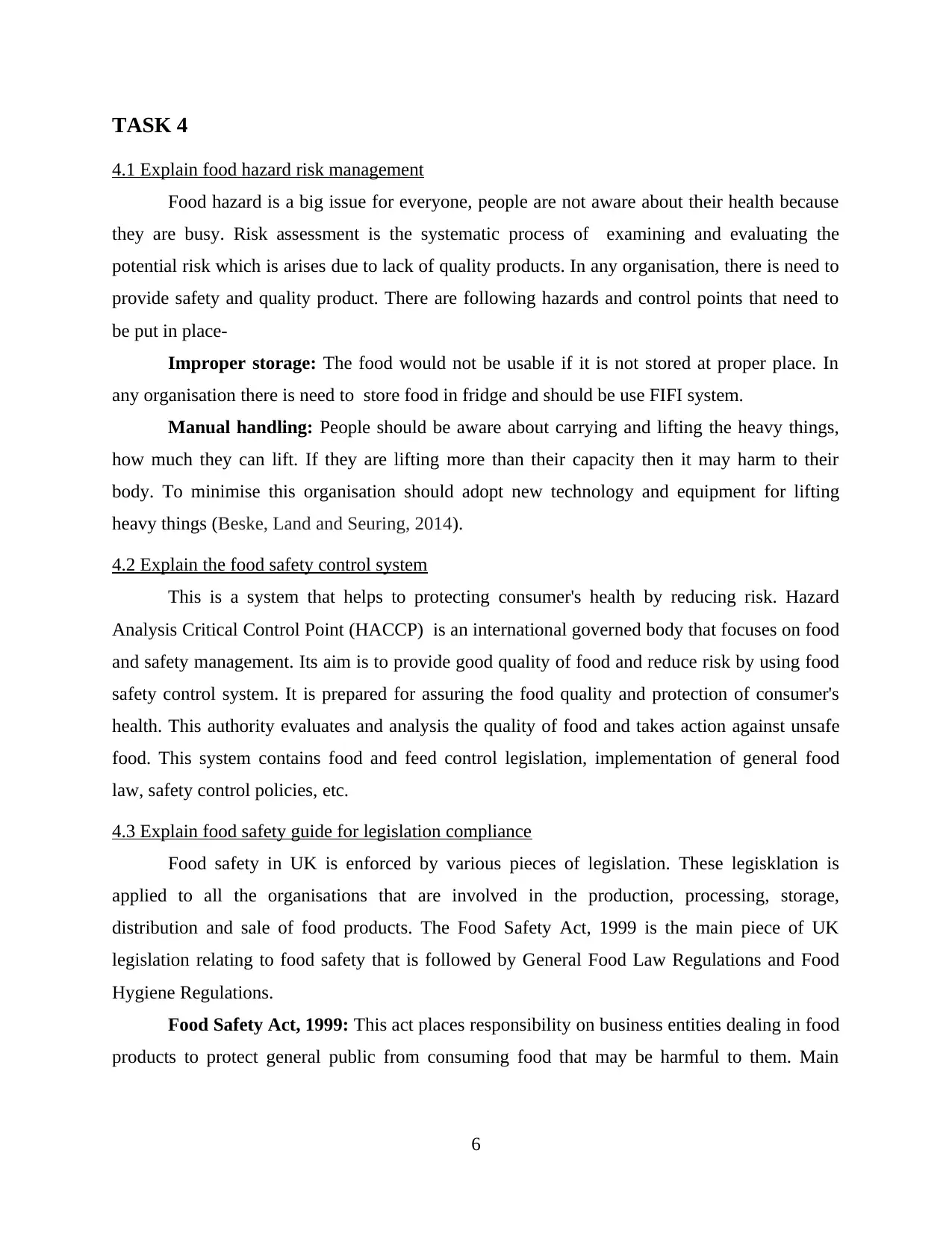
TASK 4
4.1 Explain food hazard risk management
Food hazard is a big issue for everyone, people are not aware about their health because
they are busy. Risk assessment is the systematic process of examining and evaluating the
potential risk which is arises due to lack of quality products. In any organisation, there is need to
provide safety and quality product. There are following hazards and control points that need to
be put in place-
Improper storage: The food would not be usable if it is not stored at proper place. In
any organisation there is need to store food in fridge and should be use FIFI system.
Manual handling: People should be aware about carrying and lifting the heavy things,
how much they can lift. If they are lifting more than their capacity then it may harm to their
body. To minimise this organisation should adopt new technology and equipment for lifting
heavy things (Beske, Land and Seuring, 2014).
4.2 Explain the food safety control system
This is a system that helps to protecting consumer's health by reducing risk. Hazard
Analysis Critical Control Point (HACCP) is an international governed body that focuses on food
and safety management. Its aim is to provide good quality of food and reduce risk by using food
safety control system. It is prepared for assuring the food quality and protection of consumer's
health. This authority evaluates and analysis the quality of food and takes action against unsafe
food. This system contains food and feed control legislation, implementation of general food
law, safety control policies, etc.
4.3 Explain food safety guide for legislation compliance
Food safety in UK is enforced by various pieces of legislation. These legisklation is
applied to all the organisations that are involved in the production, processing, storage,
distribution and sale of food products. The Food Safety Act, 1999 is the main piece of UK
legislation relating to food safety that is followed by General Food Law Regulations and Food
Hygiene Regulations.
Food Safety Act, 1999: This act places responsibility on business entities dealing in food
products to protect general public from consuming food that may be harmful to them. Main
6
4.1 Explain food hazard risk management
Food hazard is a big issue for everyone, people are not aware about their health because
they are busy. Risk assessment is the systematic process of examining and evaluating the
potential risk which is arises due to lack of quality products. In any organisation, there is need to
provide safety and quality product. There are following hazards and control points that need to
be put in place-
Improper storage: The food would not be usable if it is not stored at proper place. In
any organisation there is need to store food in fridge and should be use FIFI system.
Manual handling: People should be aware about carrying and lifting the heavy things,
how much they can lift. If they are lifting more than their capacity then it may harm to their
body. To minimise this organisation should adopt new technology and equipment for lifting
heavy things (Beske, Land and Seuring, 2014).
4.2 Explain the food safety control system
This is a system that helps to protecting consumer's health by reducing risk. Hazard
Analysis Critical Control Point (HACCP) is an international governed body that focuses on food
and safety management. Its aim is to provide good quality of food and reduce risk by using food
safety control system. It is prepared for assuring the food quality and protection of consumer's
health. This authority evaluates and analysis the quality of food and takes action against unsafe
food. This system contains food and feed control legislation, implementation of general food
law, safety control policies, etc.
4.3 Explain food safety guide for legislation compliance
Food safety in UK is enforced by various pieces of legislation. These legisklation is
applied to all the organisations that are involved in the production, processing, storage,
distribution and sale of food products. The Food Safety Act, 1999 is the main piece of UK
legislation relating to food safety that is followed by General Food Law Regulations and Food
Hygiene Regulations.
Food Safety Act, 1999: This act places responsibility on business entities dealing in food
products to protect general public from consuming food that may be harmful to them. Main
6

responsibilities are to ensure that food is not contaminated and served with best quality as
advertised and labelled.
General Food Law Regulations: To comply with general rules food business operator
needs to keep record of ingredients and products that are used in food product. Traceability
record of the supplier must be their with name and address, nature of the supplies, batch number
and other quality or volume and date of supply (Food Safety Legislation, 2019).
Food Hygiene Regulations: This imposes requirements on food businesss operators to
ensure that food is safe for human consumption and to enforce food hygiene requirements that
are set out in EC regulations.
CONCLUSION
From the above project report it has been concluded that for organisation that are working
in hospitality industry needs to have food safety management as their priority to survive in long
run. When ignorance is provided to food safety then it leads to contamination of food products
and gives various diseases and illness. To provide importance to health World Health
Organisation has taken each initiative possible at international level. All the organisation dealing
in food products needs to follow all the legal requirements as per Food Safety Act, 1990.
7
advertised and labelled.
General Food Law Regulations: To comply with general rules food business operator
needs to keep record of ingredients and products that are used in food product. Traceability
record of the supplier must be their with name and address, nature of the supplies, batch number
and other quality or volume and date of supply (Food Safety Legislation, 2019).
Food Hygiene Regulations: This imposes requirements on food businesss operators to
ensure that food is safe for human consumption and to enforce food hygiene requirements that
are set out in EC regulations.
CONCLUSION
From the above project report it has been concluded that for organisation that are working
in hospitality industry needs to have food safety management as their priority to survive in long
run. When ignorance is provided to food safety then it leads to contamination of food products
and gives various diseases and illness. To provide importance to health World Health
Organisation has taken each initiative possible at international level. All the organisation dealing
in food products needs to follow all the legal requirements as per Food Safety Act, 1990.
7
Secure Best Marks with AI Grader
Need help grading? Try our AI Grader for instant feedback on your assignments.
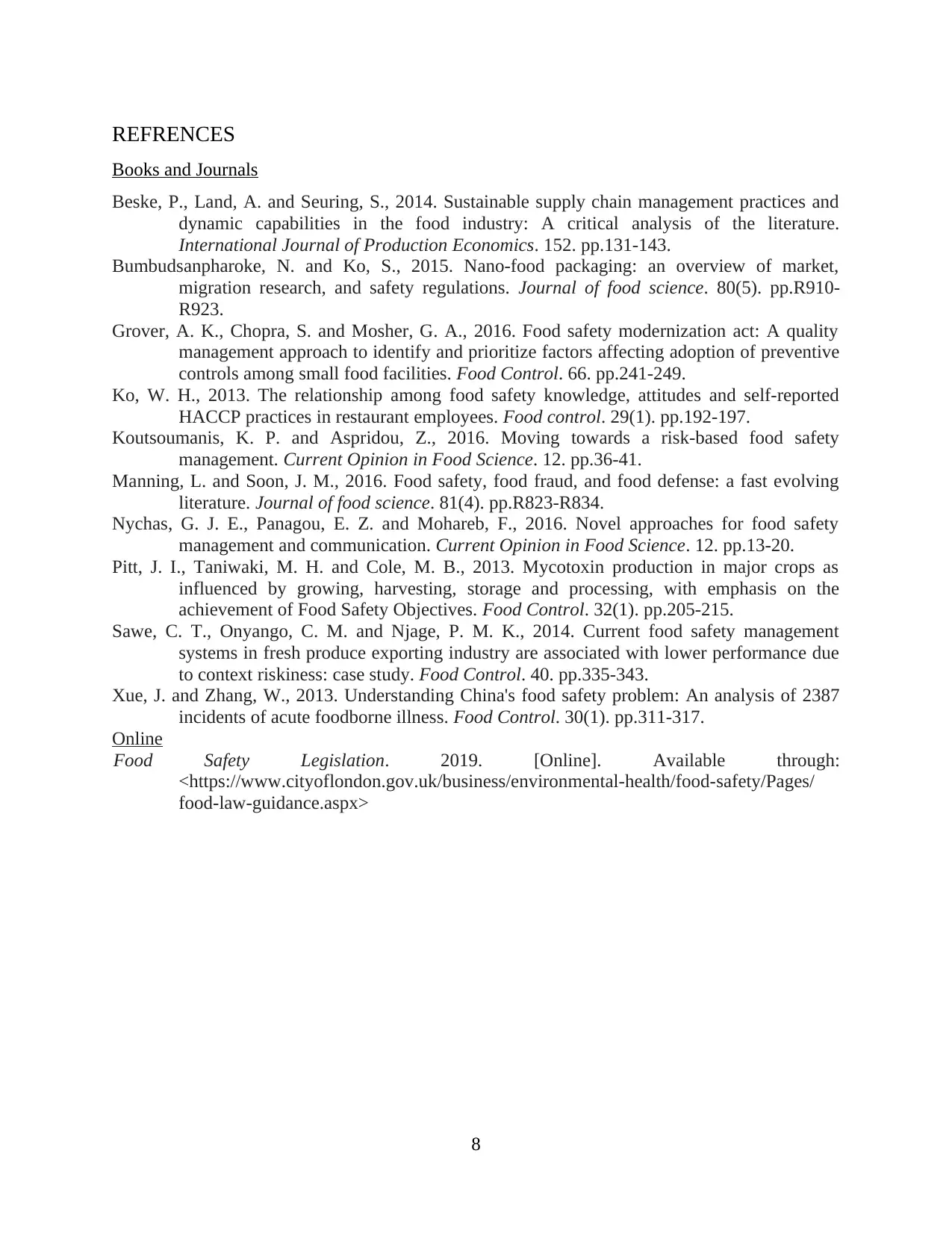
REFRENCES
Books and Journals
Beske, P., Land, A. and Seuring, S., 2014. Sustainable supply chain management practices and
dynamic capabilities in the food industry: A critical analysis of the literature.
International Journal of Production Economics. 152. pp.131-143.
Bumbudsanpharoke, N. and Ko, S., 2015. Nano‐food packaging: an overview of market,
migration research, and safety regulations. Journal of food science. 80(5). pp.R910-
R923.
Grover, A. K., Chopra, S. and Mosher, G. A., 2016. Food safety modernization act: A quality
management approach to identify and prioritize factors affecting adoption of preventive
controls among small food facilities. Food Control. 66. pp.241-249.
Ko, W. H., 2013. The relationship among food safety knowledge, attitudes and self-reported
HACCP practices in restaurant employees. Food control. 29(1). pp.192-197.
Koutsoumanis, K. P. and Aspridou, Z., 2016. Moving towards a risk-based food safety
management. Current Opinion in Food Science. 12. pp.36-41.
Manning, L. and Soon, J. M., 2016. Food safety, food fraud, and food defense: a fast evolving
literature. Journal of food science. 81(4). pp.R823-R834.
Nychas, G. J. E., Panagou, E. Z. and Mohareb, F., 2016. Novel approaches for food safety
management and communication. Current Opinion in Food Science. 12. pp.13-20.
Pitt, J. I., Taniwaki, M. H. and Cole, M. B., 2013. Mycotoxin production in major crops as
influenced by growing, harvesting, storage and processing, with emphasis on the
achievement of Food Safety Objectives. Food Control. 32(1). pp.205-215.
Sawe, C. T., Onyango, C. M. and Njage, P. M. K., 2014. Current food safety management
systems in fresh produce exporting industry are associated with lower performance due
to context riskiness: case study. Food Control. 40. pp.335-343.
Xue, J. and Zhang, W., 2013. Understanding China's food safety problem: An analysis of 2387
incidents of acute foodborne illness. Food Control. 30(1). pp.311-317.
Online
Food Safety Legislation. 2019. [Online]. Available through:
<https://www.cityoflondon.gov.uk/business/environmental-health/food-safety/Pages/
food-law-guidance.aspx>
8
Books and Journals
Beske, P., Land, A. and Seuring, S., 2014. Sustainable supply chain management practices and
dynamic capabilities in the food industry: A critical analysis of the literature.
International Journal of Production Economics. 152. pp.131-143.
Bumbudsanpharoke, N. and Ko, S., 2015. Nano‐food packaging: an overview of market,
migration research, and safety regulations. Journal of food science. 80(5). pp.R910-
R923.
Grover, A. K., Chopra, S. and Mosher, G. A., 2016. Food safety modernization act: A quality
management approach to identify and prioritize factors affecting adoption of preventive
controls among small food facilities. Food Control. 66. pp.241-249.
Ko, W. H., 2013. The relationship among food safety knowledge, attitudes and self-reported
HACCP practices in restaurant employees. Food control. 29(1). pp.192-197.
Koutsoumanis, K. P. and Aspridou, Z., 2016. Moving towards a risk-based food safety
management. Current Opinion in Food Science. 12. pp.36-41.
Manning, L. and Soon, J. M., 2016. Food safety, food fraud, and food defense: a fast evolving
literature. Journal of food science. 81(4). pp.R823-R834.
Nychas, G. J. E., Panagou, E. Z. and Mohareb, F., 2016. Novel approaches for food safety
management and communication. Current Opinion in Food Science. 12. pp.13-20.
Pitt, J. I., Taniwaki, M. H. and Cole, M. B., 2013. Mycotoxin production in major crops as
influenced by growing, harvesting, storage and processing, with emphasis on the
achievement of Food Safety Objectives. Food Control. 32(1). pp.205-215.
Sawe, C. T., Onyango, C. M. and Njage, P. M. K., 2014. Current food safety management
systems in fresh produce exporting industry are associated with lower performance due
to context riskiness: case study. Food Control. 40. pp.335-343.
Xue, J. and Zhang, W., 2013. Understanding China's food safety problem: An analysis of 2387
incidents of acute foodborne illness. Food Control. 30(1). pp.311-317.
Online
Food Safety Legislation. 2019. [Online]. Available through:
<https://www.cityoflondon.gov.uk/business/environmental-health/food-safety/Pages/
food-law-guidance.aspx>
8
1 out of 11
Related Documents
Your All-in-One AI-Powered Toolkit for Academic Success.
+13062052269
info@desklib.com
Available 24*7 on WhatsApp / Email
![[object Object]](/_next/static/media/star-bottom.7253800d.svg)
Unlock your academic potential
© 2024 | Zucol Services PVT LTD | All rights reserved.





